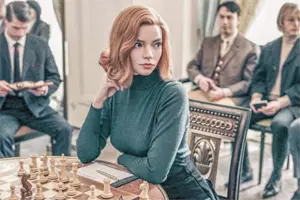The Queen's Gambit is 2020's best fantasy show because it erases sexism from the 1960s
-

The Netflix chess prodigy period limited series drama starring Anya Taylor-Joy doesn't feature women in peril or skeezy men, says Monica Hesse. That's what makes it a fantasy series. "The Queen’s Gambit is based on a 1983 novel by Walter Tevis. It’s possible the gender of the author has something to do with Beth’s uncluttered path to success," says Hesse. "Not having experienced sexism himself, he might not have thought to subject his heroine to it. He wouldn’t have realized it would be integral to her daily life. He wouldn’t know that women do not blithely follow strange men into basements. He writes Beth as a classic Greek hero, which is to say, he writes her like a man: Her biggest obstacles are her inherent flaws. And when she drinks too much, her punishment is a hangover, not an unwanted pregnancy. Regardless of whether Beth’s sexism-less ascent was born of intention or oblivion, it was jarring and thrilling to watch a woman move through her world and just be so . . . safe. I can’t help but think of all the other esteemed period pieces, with all their other period sexism. Joan in Mad Men endured harassment every day. And while that was probably true to life, it still meant that we viewers had to watch a woman’s humiliation repeatedly played out as plot. Game of Thrones, set in an alternate Medieval English reality, relied heavily on rape and then argued that because rape was a part of historical violence, it was accurate to depict it on the show. Which, fine. But you would think that a show that featured dragons and ice-walking zombies might also be able to envision a world in which sexual violence isn’t a thing. This is the fantastical world The Queen’s Gambit gives us. And it’s at least some of why — even if viewers haven’t put their fingers on it — the show is so dang satisfying. Partly because it depicts a brilliant woman. And partly because it depicts decent men. Beth is able to get where she does because they see her as an equal instead of as a threat. It’s revisionist history. It would be a wonderful future."
ALSO:
- The Queen's Gambit is a "fake deep period piece" -- it's the Forrest Gump of chess: Critics have repeatedly compare The Queen's Gambit to Mad Men and even The Crown. "Whether evoking Mad Men or The Crown, these comparisons always wind back to the show’s aesthetic pleasures, suggesting that it depicts history less by way of content than style," says Jane Hu. "But a better comparison for The Queen’s Gambit would be The Marvelous Mrs. Maisel. Both shows knock you out with their overly lush costume design and production, while their beautiful white heroines somehow slip unscathed past all the roiling traumas of their respective ages. The Queen’s Gambit might as well be the Forrest Gump of chess. It is what one friend dubbed a 'fake deep period piece.'" The Netflix series, she adds, "offers a different vision of the Cold War — a happier, less paranoid one. Russia is not villainous in The Queen’s Gambit, and that seems precisely the point. While the country is structurally set up to be Beth’s (and by extension, America’s) opposition, the Soviets end up representing something closer to virtuous gamesmanship. The final episode, in which Beth travels to Russia to compete against grand master Vasily Borgov, is a remarkably optimistic one. With the collective help of chess-playing men from her past, Beth takes home the title, winning through a collaborative effort that feels remarkably Soviet. There is something off about the way Beth represents American national spirit as one that trusts in teamwork. The Queen’s Gambit represents an America at the crossroads of global conflict as one that can turn potential war into a positive feeling."
- The Queen's Gambit is a universal hit because it evokes Rocky and other sports films: "The sports epic is built into the structural DNA of The Queen’s Gambit, which is likely at least partially responsible for the viewer response to the series," says Libby Hill. "We know how these stories work, and we know what we want to see from them. Taylor-Joy is a charismatic and intriguing presence, not unlike — but also, obviously, completely unlike — a young Sylvester Stallone in Rocky and she draws your focus so that even when the story drags, it’s impossible to tear your eyes away. And yet The Queen’s Gambit feels like something more. The chic costumes and luxurious production design, the central competition revolving around an intellectual game (rather than a physical one), the focus on a woman (Sorry, The Next Karate Kid, starring Hillary Swank), all of it repackaging a story that we know and love in the prettiest wrapping paper money can buy, somehow transforming it into something more than a sum of its parts."
- Why The Queen's Gambit looks so good: Cinematographer Steven Meizler explains his vision, including showing Beth's point of view and demonstrating her progression through immersive long takes. He also mirrored German Expressionism through light and shadow contrasts, while making chess look dynamic and interesting.
- How The Queen's Gambit compares to Walter Tevis' 1983 novel
- The Queen's Gambit is not only boosting chess set sales, but also sales of chess books
- Here are the sexiest chess locations on The Queen's Gambit
TOPICS: The Queen's Gambit, Netflix, Anya Taylor-Joy
More The Queen's Gambit on Primetimer:
